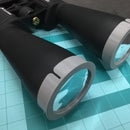Introduction: De-Rust Your Old Table Saw
I purchased an old rusty table saw from the local classifieds. It was a great deal, but it was very rusty - rusty enough that it was hard to use and desperately needed help. Here's how you can remove the rust from your old table saw and give it a new lease on life as a useful tool!
Step 1: Cut the Rust
The first thing to do is to remove your blade insert, the blade itself, your fence, miter gauge, etc. If you're so inclined, you can also remove the rails that your fence rides on. In my case, they needed little TLC anyway.
Use a putty knife or similar scraper to knock down the high rust spots and to make everything flat. You're not trying to cut into the metal or to scrape really hard, you just want to knock off the loose rust. Be careful not to gouge the surface, you want it to be as smooth and as flat as possible.
Step 2: Apply a Rust Remover
Now that you've got the loose rust removed, it's time to apply a rust stripper. I used a product from Rust-Oleum, but many other products exist. Traditionally, this sort of product is called 'Naval Jelly' and can be found at most automotive and home improvement stores.
Wear gloves and safety glasses! These chemicals can burn your skin. You also want to work in a well ventilated area. Open a door and set up a fan to keep the air moving, you don't want to breathe the nasty fumes from these chemicals, trust me.
Apply enough rust stripper so that you can slather on an even, wet coat of it with your gloves. Don't forget about the miter slots and edges. Make sure to coat everything while being careful to keep the stripper out of the inner workings of the saw.
Follow the instructions on the product that you end up using - mine said to let the chemical work for about 20 minutes before removing it. After the allotted amount of time, wipe the rust remover off with a rag or paper towel. The grime that you remove will be brown with rust. Reapply another coat of rust remover and repeat this process until there isn't any more visible rust and the chemical that you wipe off is gray with steel instead of orange with rust.
Step 3: Clean the Bare Metal
After removing the orange and brown rust from your table saw, the table still may not be clean and smooth. To knock down the rest of the rough spots, use an automotive rubbing compound or metal polish and a buffing wheel. You can use an orbital buffer or a polishing arbor in a drill.
Make sure to use products that do not contain silicone. Silicone will stay on the table and contaminate the wood that you cut, causing imperfections in anything that you paint. If you're not sure whether or not the product you're using contains silicone, look up the chemical's MSDS sheet and see if it contains "siloxanes".
Step 4: Apply Wax
After you're finished polishing the table's surface, wipe it down with a solvent like acetone until your rag comes off of the table clean. This will remove any chemicals that may still be on the table and ensure that there isn't anything left on the surface that might interact with the wax coat. Again, don't forget about the miter slots and edges.
After everything is clean, apply wax to seal the table's finish and to lubricate the surface. Most woodworkers will tell you to use Johnson's Paste Wax. I found it at my local hardware store. The product is sold as a flooring wax.
Apply the wax just like you're waxing a car. Apply a full layer, allow it to dry for 15-20 minutes (you'll see the wax haze over) and wipe it off. Since you're applying the wax to bare metal for the very first time, repeat this process at least one more time to make sure that all of the machining marks and surface imperfections are filled with the wax.
Step 5: Reassemble the Table
After you've applied an nice coat of wax to the surface, you can reinstall everything on your table. It's a good idea to clean everything as you put it back on. I used the same rag that I waxed the table with so that everything ended up with a thin coat of the slick wax.
Reinstall your fence, insert your blade insert, etc.
Step 6: Enjoy!
After everything's back together, your saw is ready for service again. Take a step back and admire the awesome job that you've done!
To keep your saw from rusting over again, avoid exposing it to moisture. This is difficult to do in the average garage or workshop, but you can take steps to reduce exposure. Avoid setting drinks and other tools on top of the table that might contain moisture. You should also periodically reapply a coat of wax to protect the surface.
Your saw's new finish, if properly maintained, will last for the life of the tool and serve you well. Enjoy!





